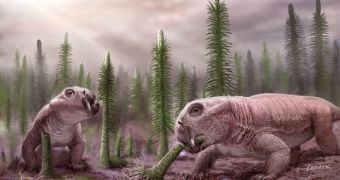A collaboration of American researchers recently managed to gain new insight into how land-based life evolved after the Permian–Triassic extinction event, which occurred about 251.4 million years ago. The team found that life did not immediately bounce back.
This event is widely known as the Great Dying, named thusly because it killed as much as 96 percent of all marine species and 70 percent of all terrestrial vertebrate species. It is also the only known extinction that affected insects. In all, more than 83 percent of all genera were annihilated.
The result was a world populated by disaster taxa. These are forms of animals that existed previously, which managed to endure the extreme devastation. Not all types of creatures endured the event. A wide number of species was wiped out entirely.
In the new study, researchers from the Brown University and the University of Utah managed to demonstrate that life was unable to bounce back immediately after the end-Permian extinction. Species first underwent a series of botched attempts to recolonize the planet.
What this means is that various genera and species developed for a time, then experienced population collapses due to harsh conditions. The process later repeated itself several times over, the team says. Researchers add that this cycle lasted for about 8 million years.
Details of the new investigation were published in the latest issue of the esteemed scientific journal Proceedings of the Royal Society B. These conclusions were drawn after scientists conducted an exhaustive specimen-by-specimen analysis of whatever fossils they uncovered from that time.
“It means the (terrestrial ecosystems) were more subject to greater risk of collapse because there were fewer links” in the food chain, explains Brown University assistant professor of geological sciences Jessica Whiteside, who was also a coauthor on the new paper.
Species could only recover through processes such as incremental evolution and speciation, which take a very long time to lead to positive results. Speciation is the term scientists use to refer to the creation of new species.
According to Natural History Museum of Utah curator of paleontology and study coauthor Randall Irmis, these trial-and-error cycles can be referred to as small extinction events and recoveries. Still, the trend when it came to overall survival went upwards, and life eventually rebounded.
Irmis, who is also an assistant professor of geology and geophysics at the University of Utah, says that the research team analyzed a total of 8,600 fossilized specimens for this research.

 14 DAY TRIAL //
14 DAY TRIAL //